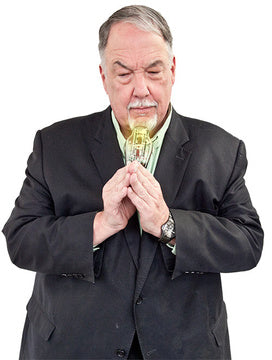This column is different from previous installments of Vintage Whine, in two ways:
1. Previous subjects were pretty well known—for anyone familiar with the history of the American audio industry, anyway. Stan White isn’t well known.
2. Stan White is the first subject I’ve known, personally—which makes this both easier, yet more difficult, to write. The reasons will become clear as we proceed.
For audio geeks of the pre-internet era of the ‘70’s, classified ads in the back of Audio magazine were the best source of news about leading-edge tech as well as breaking brands and products. Given the when?-if-ever publication schedules of both Stereophile and TAS during that era, blurbs in the Audio classifieds often preceded news pieces in the other mags by as much as a year. –And as far as tweak brands went, fuhgeddabout Stereo Review and High Fidelity, the mainstream consumer audio mags of the day. Audio itself tap-danced between stodgy tech reporting (the brilliant but often opaque Richard Heyser), and a surprisingly whimsical view of the worlds of music and audio (Edward Tatnall Canby, Bert Whyte, Professor I. Lirpa!).
As with tiny classifieds everywhere, one could find sincere announcements of major breakthroughs, right next to straight-faced declarations of bombastic hype. That’s where I first encountered Stan White—somewhere between those two extremes.
Somewhere around ’75-’76, as a teenager already fully invested in high-end audio (intellectually, if not financially—I was a charter subscriber to TAS, because of another classified ad in Audio), I saw display classifieds in Audio for “Shotglass” glass-coned speakers from Stan White. I initially assumed that meant cones made out of something like my mother’s Pyrex baking dishes. “How is THAT supposed to work?”
Without knowing it, I’d been introduced to Stan White’s marketing, which often included cutesy, somewhat vague terminology that baffled as often as it enlightened, leaving one feeling a little annoyed. Ever had a too-loud uncle who tried too hard to be “hip”? Yeah, like that. The backlash of the Vietnam war was way too many graying guys with long sideburns and flowered shirts. My first take on Stan White and his products was of such a character, selling speakers that had barely escaped from a white van (no pun intended).
I was both right and wrong.
When my children see movies or TV from the psychedelic era of the late ‘60’s through the early ‘70’s, they tend to roll their eyes. My standard comment to them is, “you had to be there”. Viewing such things dispassionately from a distance cannot explain the laughable monstrosities of the era: think Bing Crosby’s wince-inducing album, Hey Jude, Hey Bing. How on Earth could that have been thought to be a good idea? –and yet, there it is.
Similarly, to look at either the White speakers or the sales brochure shown in this ebay listing is to cringe: who thought of the Bozo the Clown color scheme of sky blue driver-surrounds and clown-nose red center cap against a whitish cone?
Who was this guy Stan White?
Here’s what I know, based upon email correspondence and phone conversations with Stan, which took place between 2003-05: Stanley Fay White was born in Minneapolis circa 1920, and lived in St. Paul until the death of his mother when he was 7. Where he went from there, I don’t know–but he became involved in studying Physics, and like many others, enrolled in the armed forces in WW II.
Stan told me, “ I was a transatlantic weather forecaster. I was part of a small group that destroyed the U-Boat menace in early 1943. (planes and depth charges). I never lost a plane due to faulty forecast, ever. I was put in charge of General Brooks (Brooksfield, Texas) headquarters weather station at age of 21. I was the General’s pet. He used to win bets on my forecasts.” He also served for 18 months during the Korean War.
After being discharged the second time, Stan designed and began marketing speakers and amps that showed a curious mix of advanced technology and bombast. Look at this collection of ads and pics, and you’ll see technical claims that might cause an eyebrow to be raised, along with pretty girls and celebrity endorsements: Duke Ellington, great—but Charlton Heston?!? http://www.itishifi.com/search/label/Stan White
The ad for Stan’s “4D” speaker is noteworthy not just for the lovely young lady in the bizarre outfit, but for grandiose claims of superiority which are accompanied by surprisingly little information. Stan’s was certainly not the only hi-fi company whose ads featured such lingo—it was the ‘50’s, era of tail-fins— but even for the time, “4-dimensional sound with power and clarity you must hear to believe” and “THE MIRACLE OF MULTI-FLARE” are a little over the top.
Even a product info sheet simply describes the 4D as having “horns, horns, and more horns”. Its 5’7” height and 400 pound weight indicated it was a substantial product, and the 1954 price of $1500 was a substantial investment, as well. That’s around $13,400 in 2016 bucks.
That $1500 price was also more than double the cost of a JBL Hartsfield or Electrovoice Patrician, widely regarded as the best of the day. A Klipschorn was only about a third of the price of the 4D. In all the years I’ve dealt with vintage gear, I’ve never seen any Stan White speaker, much less a 4D, nor have I ever met anyone who had experience with them.
Were the 4Ds real, or just imaginary halo products created to cast glamour upon lesser speakers? I’m not sure.
Next time we’ll look at some patents, and some info that indicates that a bright mind was at work. But always…that hype….
Bill Leebens has bought and sold vintage gear since the days when it was new. He regrets that a goodly number of classic American components now reside in Japan, because of him. Mea culpa.




